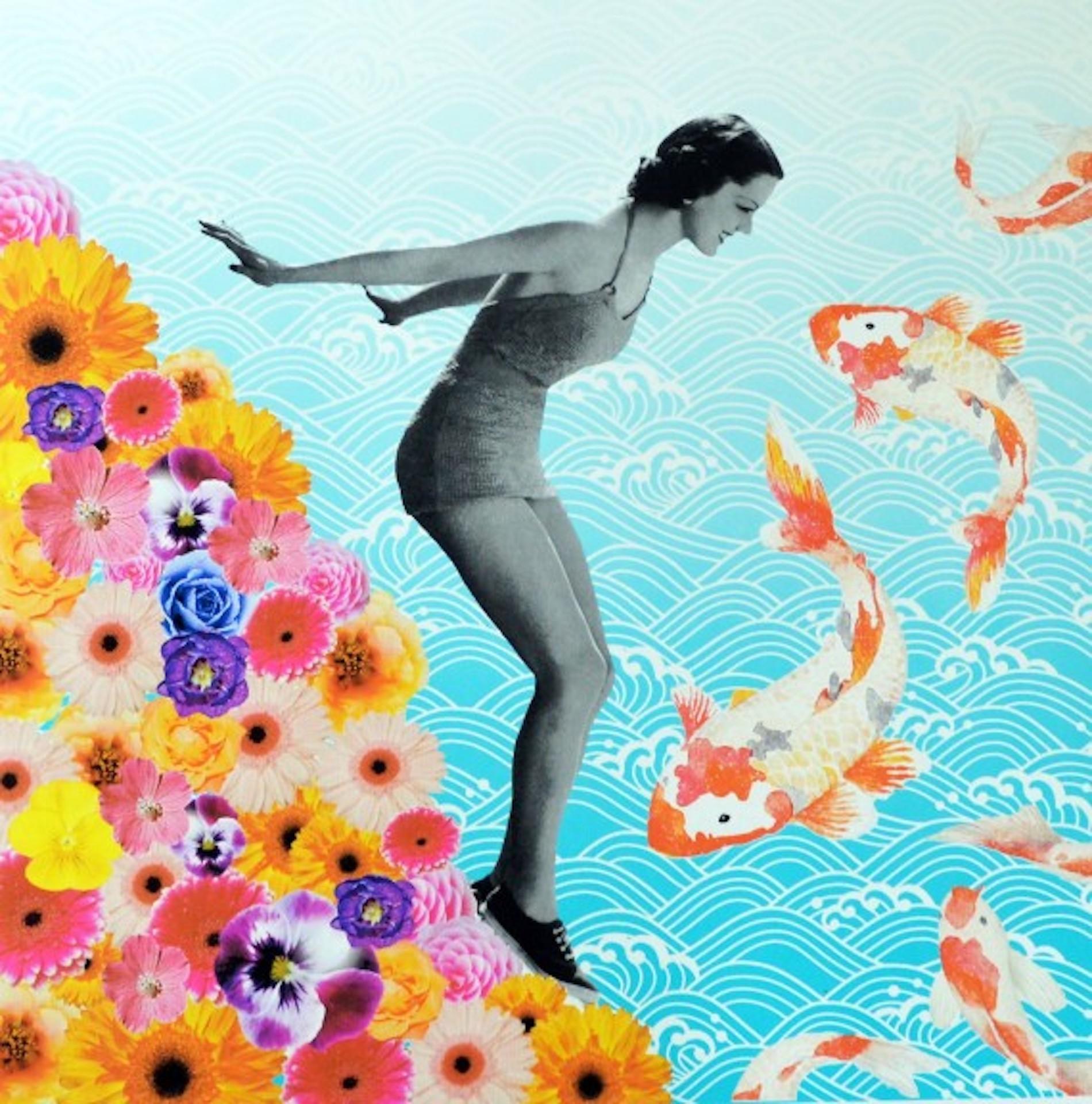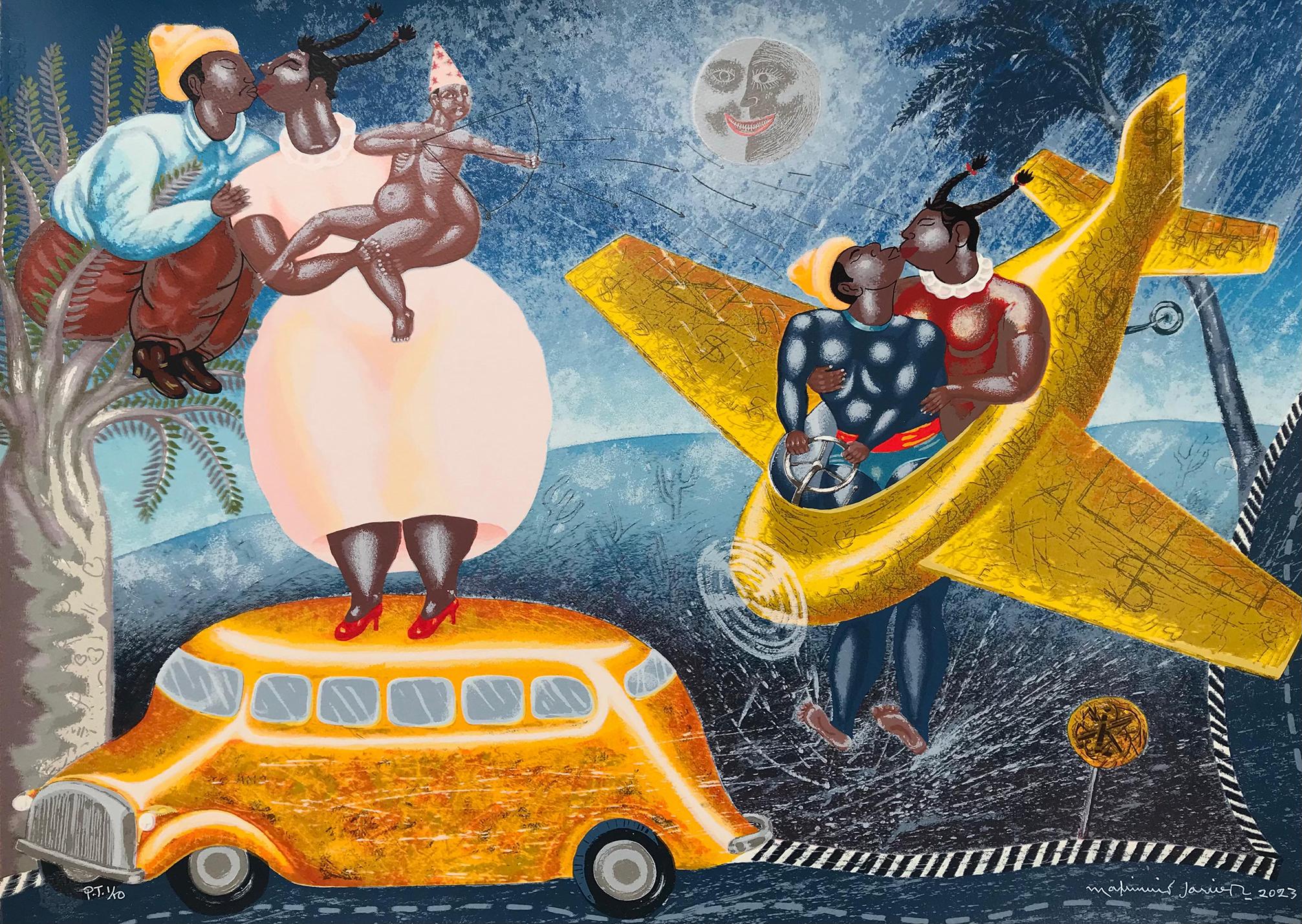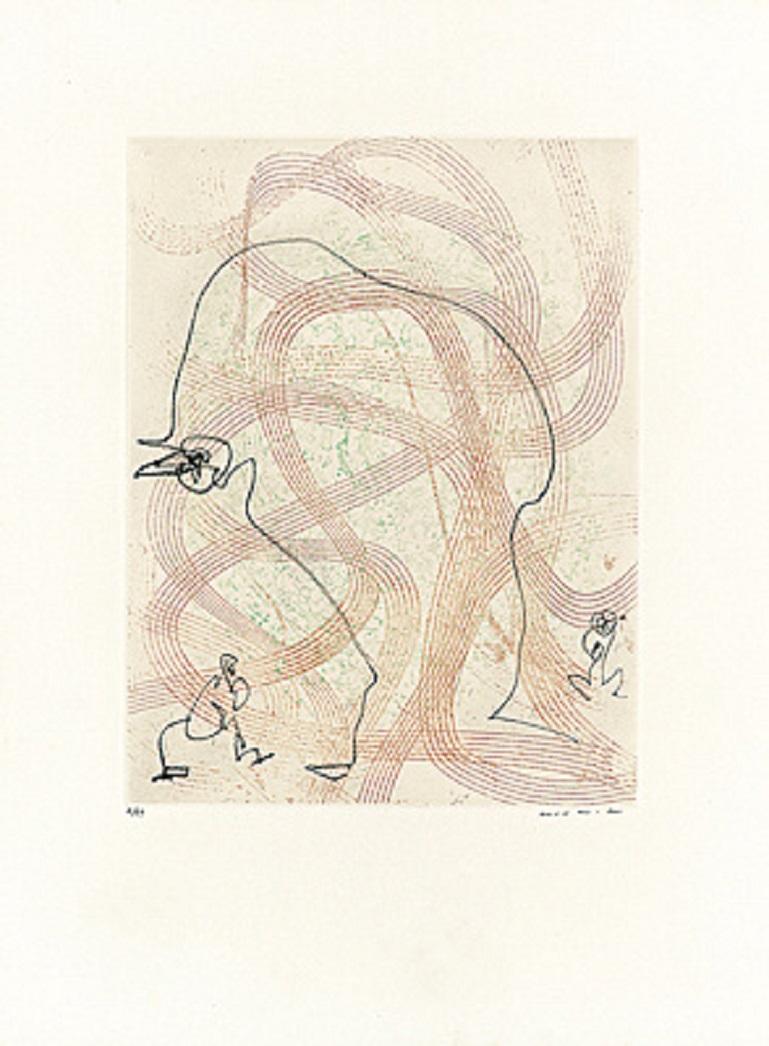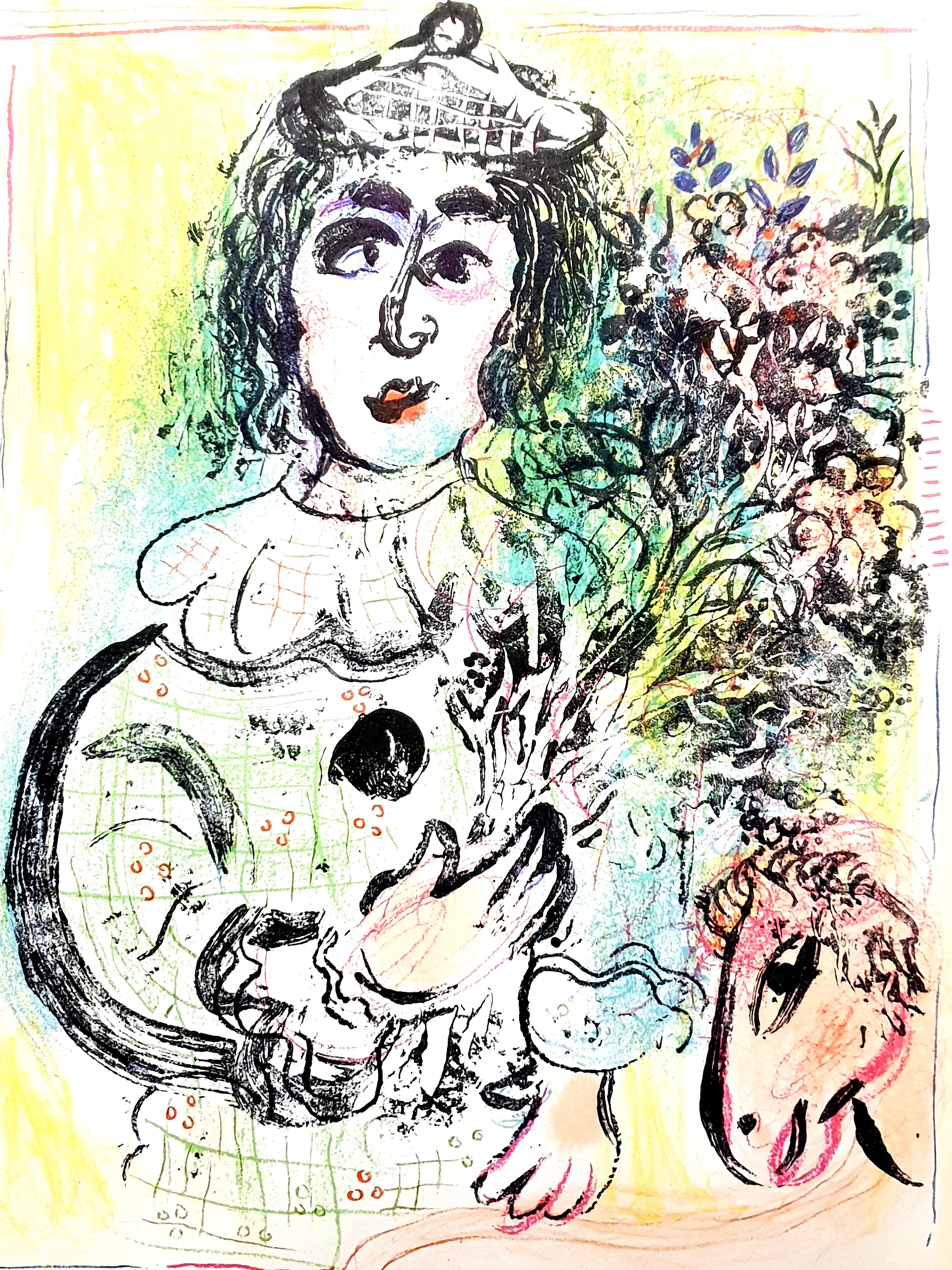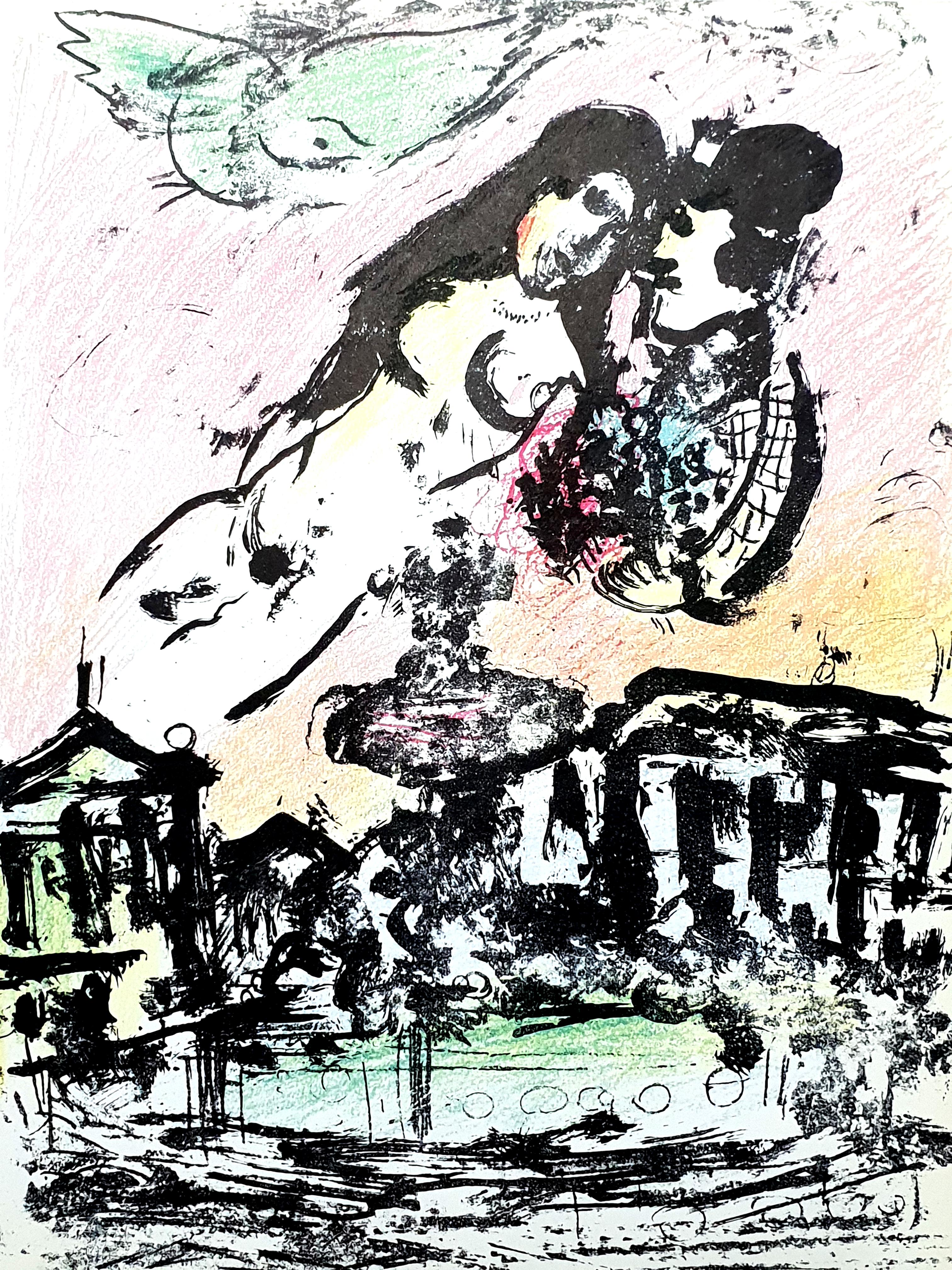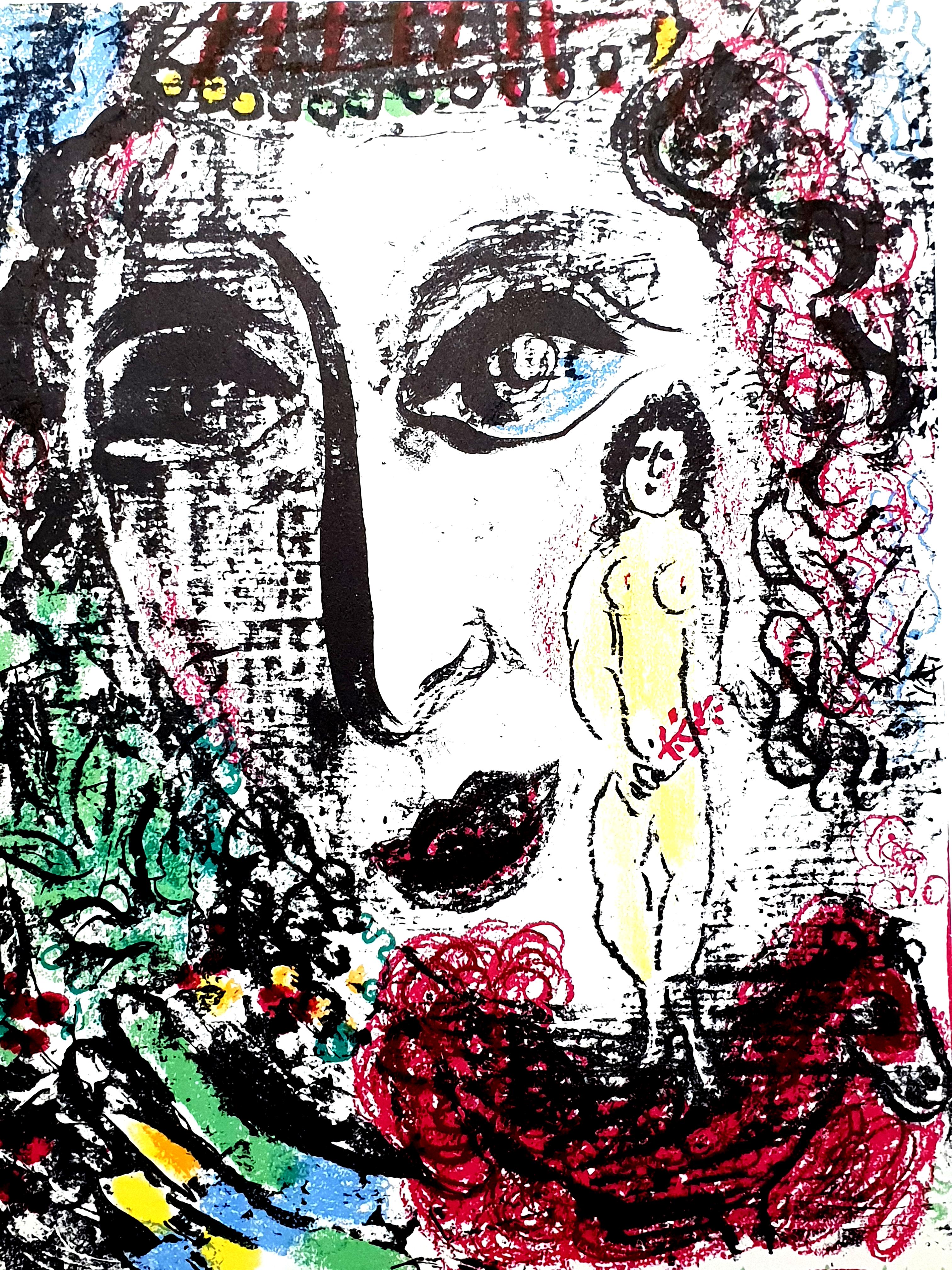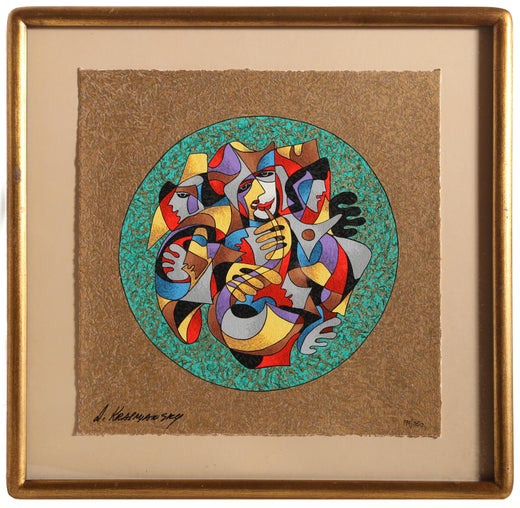Items Similar to Old City of Warsaw
Want more images or videos?
Request additional images or videos from the seller
Anatole KrasnyanskyOld City of Warsaw1994
1994
About the Item
This artwork titled "Old City of Warsaw" 1994 is an original color serigraph by Ukrainian/American artist Anatole Krasnyansky, 1930-2023. It is hand signed, titled and numbered 117/275 in black pencil by the artist. The artwork (image) size is 15.35 x 21.85 inches, framed size is 25.5 x 31.5 inches. Custom framed in a wooden silver and brown colors distressed style frame, with of- white matting and gold color fillet. It is in excellent condition, the frame have minor restorations, barely visible.
About the artist:
Anatole Krasnyansky (born in 1930; Kiev, Ukraine) is a Ukrainian-American artist who has gained prominence by pioneering a new watercolor technique. Krasnyansky added paper texture as a component of his watercolors. With this new process, Krasnyansky added texture and depth to the watercolor medium and expanded its expressive possibilities to a level usually associated with oil painting.
Biography
He was born in Kiev, growing up and living during the times when Ukraine was a part of the U.S.S.R. Krasnyansky received master's degrees in fine art and architecture. He found that the freedom of expression that he needed in his artwork could not be found within the strictures of the Soviet Union and moved to the United States in 1975.
In the U.S., Krasnyansky found valuable use for his knowledge of architecture, design and his imagination. and found success in multiple artistic pursuits. Almost surreal, Krasnyansky’s figures are recognizable form while incorporating elements of his Eastern heritage, the cubist ideas of Picasso and Braque, and as well as American culture.
Accomplishments
Krasnyansky began working as a scenic artist for ABC and CBS, including the production of two Academy Awards shows. He became a set designer for Universal Studios (credits including The Blues Brothers and Battlestar Galactica) and the stage art director for the Odyssey Theatre.
Krasnyansky is also known for his surrealist masked figures.
Krasnyansky's work has been exhibited at the Dalzell Hatfield Galleries in their exhibition "International Watercolor Masters," along with works from Marc Chagall, Camille Pissarro, and Diego Rivera. Krasnyansky's work has been featured in exhibitions at Stanford University and UCLA and has also been shown in solo exhibitions in Japan and around the United States.
- Creator:Anatole Krasnyansky (1930, Russian)
- Creation Year:1994
- Dimensions:Height: 25.5 in (64.77 cm)Width: 31.5 in (80.01 cm)Depth: 1.1 in (2.8 cm)
- Medium:
- Movement & Style:
- Period:
- Condition:
- Gallery Location:San Francisco, CA
- Reference Number:
Anatole Krasnyansky
is a contemporary American-Ukrainian artist, best known for his watercolors and cityscapes. His work conflates themes of music, theater, architecture, and culture through colorful figurations set in non-Euclidean space. Born in 1930 in Kiev, Ukraine, Krasnyansky earned his master’s in architecture and fine art before emigrating from the Soviet Union in 1975 to pursue his career in Los Angeles, CA. His structural aesthetic is shaped by his previous work as an architect, as well as having served as a scenic artist in the theater industries. Notably, Krasnyansky developed a unique process of textural watercolor painting, where his paper works reference Eastern culture and heritage through color relationships and architectural features. Currently living and working in Los Angeles, CA, Krasnyansky has exhibited internationally, including at institutions such as Stanford University in Palo Alto and at the University of Los Angeles.
About the Seller
5.0
Platinum Seller
These expertly vetted sellers are 1stDibs' most experienced sellers and are rated highest by our customers.
Established in 1999
1stDibs seller since 2017
686 sales on 1stDibs
Typical response time: 1 hour
- ShippingRetrieving quote...Ships From: San Francisco, CA
- Return PolicyA return for this item may be initiated within 7 days of delivery.
More From This SellerView All
- HomerBy Valerio AdamiLocated in San Francisco, CAThis artwork titled "Homer" 1979 is an original colors serigraph on Stonehenge Wove paper by noted Italian artist Valerio Adami, b.1935. It is hand signed and numbered 6/75 in pencil by the artist. Published by Editions Press, San Francisco. The image size is 37.5 x 21.75 inches, framed size is 45.75 x 29.15 inches. Custom framed in a metal gold frame, with beige fabric matting. The artwork is in excellent condition, the frame is in very good condition, it has some minor scratches. About the artist: Valerio Adami was born in Bologna. In 1935, at the age of ten, he began to study painting under the instruction of Felice Carena. He was accepted into the Brera Academy (Accademia di Brera) in 1951, and there studied as a draughtsman until 1954 in the studio of Achille Funi. In 1955 he went to Paris, where he met and was influenced by Roberto Matta and Wifredo Lam. His first solo exhibition came in 1959 in Milan. In his early career, Adami's works were expressionistic, but by the time of his second exhibition in 1964 at Kassel, he had developed a style of painting reminiscent of French cloisonnism, featuring regions of flat color bordered by black lines. Unlike Gauguin, however, Adami's subjects were highly stylized and often presented in fragments, as seen in Telescoping Rooms (1965). In the 1970s, Adami began to address politics in his art, and incorporated subject matter such as modern European history, literature, philosophy, and mythology. In 1971, he and his brother Gioncarlo created the film Vacances dans le désert. In 1974 he illustrated a Helmut Heissenbuttel poem, Occasional Poem No. 27. Ten Lessons on the Reich with ten original lithographs {Gallerie Maeght...Category
Late 20th Century Modern Figurative Prints
MaterialsScreen
- "Doreen" - Large original color serigraphBy Rudolph Carl GormanLocated in San Francisco, CAThis artwork, titled "Doreen", done in 1983, is an original color serigraph by renown Navajo artist Rudolph Carl Gorman, 1932-2005. It is hand signed and numbered E.P.I. in pencil by the artist ( E.P.I. refers to "Editions Press Impression", one of ten impressions done for the publisher.) With the blind stamp of the artist and the printer, Editions Press, San Francisco. The edition size was 150 plus proofs (a total of 45 proofs). The sheet size is 26.25 x 33.25 inches, framed size is 39.25 x 45.25 inches. Custom framed in a wooden oak frame, it is floating, with a deep red liner and with natural linen matting. The artwork is in excellent condition. The frame is in very good condition, it has minor restorations, practically invisible. Medium: Serigraph on Paper Dimensions: 26 1/4" x 33 1/4" Year Produced: 1983 Edition Size: 150 plus proofs (45 proofs) About the artist: Born in Canyon de Chelly, Arizona and raised in a hogan on the Navajo Reservation, R.C. Gorman became one of the Southwest's best known late 20th-century artists. His signature works were Navajo women in a variety of poses. Many persons have been fascinated by the fact that he, an Indian artist, became famous in the white man's world with some calling him the "Picasso of Indian artists". Of this kind of attention, he said: "I wish people would quit pushing my being Indian. The only time I was interviewed as If I were a normal person was by the Jewish Press in Tucson. It was the first time I felt international and almost white". (Samuels 222) His parents were Carl Nelson...Category
Late 20th Century Realist Figurative Prints
MaterialsScreen
- "Woman from Maui" Large original color serigraph.By Rudolph Carl GormanLocated in San Francisco, CAThis artwork titled "Woman from Maui" 1983 Is an original color serigraph by renown Navajo artist Rudolph Carl Gorman, 1932-2005. It is hand signed and inscribed E.P.I in pencil by the artist. With the blind stamp of the artist and the printer, Editions Press, San Francisco. The sheet size is 28.5 x 33.35 inches, framed size is 41.25 x 45.25 inches. Custom framed in a wooden off white frame, with off white matting and bevel. the artwork is in excellent condition, the frame is in very good condition, it has minor restorations, practically invisible About the artist: Born in Canyon de Chelly, Arizona and raised in a hogan on the Navajo Reservation, R.C. Gorman became one of the Southwest's best known late 20th-century artists. His signature works were Navajo women in a variety of poses. Many persons have been fascinated by the fact that he, an Indian artist, became famous in the white man's world with some calling him the "Picasso of Indian artists". Of this kind of attention, he said: "I wish people would quit pushing my being Indian. The only time I was interviewed as If I were a normal person was by the Jewish Press in Tucson. It was the first time I felt international and almost white". (Samuels 222) His parents were Carl Nelson...Category
Late 20th Century Realist Figurative Prints
MaterialsScreen
- PreludeBy Valerio AdamiLocated in San Francisco, CAArtist: Valerio Adami – Italian (1935- ) Title: Prelude Year: 1979 Medium: serigraph Sight size: 29.75 x39.5 inches. Sheet size: 29.75 x 39.5 inches Signature: Signed lower right Ed...Category
1970s Modern Figurative Prints
MaterialsScreen
- PlatformLocated in San Francisco, CAThis artwork titled "Platform" 1963 is an original silkscreen by American artist Kenneth William Auvil, 1925-1999. It is signed, dated, titled and numbered 9/27 in pencil by the artist. The image size is 17 x 11.25 inches, framed size is 23.5 x 17.65 inches. Custom framed in a bronze color metal frame. It is in good condition, paper is slightly toned by age. About the artist: Educational Background University of Washington, 1953 MFA Art University of Washington, 1949 BA Art Teaching Experience San Jose State University, 1956 -1988 Selected Publications Serigraphy: Silk Screen Techniques for the Artist, Prentice‑Hall, 1965‑1996. Activities: Learning to Use the Macintosh Computer...Category
Mid-20th Century American Modern More Prints
MaterialsScreen
- La Seine a Paris, Large original color serigraphLocated in San Francisco, CAThis artwork :La Seine a Paris" c.1990 is an original color serigraph on hand made paper by American artist Linea Pergola, b.1953. It is hand signed and numbered A.P. 25/50 in pencil...Category
Late 20th Century American Modern Figurative Prints
MaterialsScreen
You May Also Like
- Anne Storno, Water Baby, Affordable Art, Colourful Art Limited Edition PrintBy Anne StornoLocated in Deddington, GBAnne Storno Water Baby A limited edition of 30. Image Size: H:50 cm x W:50 cm Paper Size: H60cm x W60cm Sold Unframed Please note that in situ images are purely an indication of how ...Category
21st Century and Contemporary Surrealist Figurative Prints
MaterialsPaper, Screen
- Maximino Javier Mexican artist original hand signed silkscreen surrealismBy Maximino JavierLocated in Miami, FL"Maximino Javier (Mexico, 1948) 'Bajada de emergencia (serie Tamayo Total)', 2023 silkscreen on paper Canson 320 g. 20.3 x 28.2 in. (51.5 x 71.5 cm.) Edition of 100 Unframed ID: JAV-...Category
2010s Surrealist Figurative Prints
MaterialsCotton, Paper, Screen
- "Bonjour" by Max Ernst, Good Day, Surrealism, Light Colors, FigurativeBy Max ErnstLocated in Köln, DEEtching in colours by Max Ernst. "Bonjour", 1966 66,5 x 50,1 cm Copy 7/99 Edition of 111 copies (approx.)Category
1960s Surrealist Figurative Prints
MaterialsEtching, Aquatint
- Marc Chagall - Flowered Clown - Original LithographBy Marc ChagallLocated in Collonge Bellerive, Geneve, CHMarc Chagall Original Lithograph 1963 Dimensions: 32 x 24 cm From Chagall Lithograph II Reference: Mourlot 399 Condition : Excellent Unsigned and unumbered as issuedCategory
1960s Surrealist Figurative Prints
MaterialsLithograph
- Marc Chagall - Original LithographBy Marc ChagallLocated in Collonge Bellerive, Geneve, CHMarc Chagall Original Lithograph 1963 Dimensions: 32 x 24 cm Reference: Chagall Lithographe 1957-1962. VOLUME II. Condition : Excellent Marc Chagall (born in 1887) Marc Chagall was born in Belarus in 1887 and developed an early interest in art. After studying painting, in 1907 he left Russia for Paris, where he lived in an artist colony on the city’s outskirts. Fusing his own personal, dreamlike imagery with hints of the fauvism and cubism popular in France at the time, Chagall created his most lasting work—including I and the Village (1911)—some of which would be featured in the Salon des Indépendants exhibitions. After returning to Vitebsk for a visit in 1914, the outbreak of WWI trapped Chagall in Russia. He returned to France in 1923 but was forced to flee the country and Nazi persecution during WWII. Finding asylum in the U.S., Chagall became involved in set and costume design before returning to France in 1948. In his later years, he experimented with new art forms and was commissioned to produce numerous large-scale works. Chagall died in St.-Paul-de-Vence in 1985. The Village Marc Chagall was born in a small Hassidic community on the outskirts of Vitebsk, Belarus, on July 7, 1887. His father was a fishmonger, and his mother ran a small sundries shop in the village. As a child, Chagall attended the Jewish elementary school, where he studied Hebrew and the Bible, before later attending the Russian public school. He began to learn the fundamentals of drawing during this time, but perhaps more importantly, he absorbed the world around him, storing away the imagery and themes that would feature largely in most of his later work. At age 19 Chagall enrolled at a private, all-Jewish art school and began his formal education in painting, studying briefly with portrait artist Yehuda Pen. However, he left the school after several months, moving to St. Petersburg in 1907 to study at the Imperial Society for the Protection of Fine Arts. The following year, he enrolled at the Svanseva School, studying with set designer Léon Bakst, whose work had been featured in Sergei Diaghilev's Ballets Russes. This early experience would prove important to Chagall’s later career as well. Despite this formal instruction, and the widespread popularity of realism in Russia at the time, Chagall was already establishing his own personal style, which featured a more dreamlike unreality and the people, places and imagery that were close to his heart. Some examples from this period are his Window Vitebsk (1908) and My Fianceé with Black Gloves (1909), which pictured Bella Rosenfeld, to whom he had recently become engaged. The Beehive Despite his romance with Bella, in 1911 an allowance from Russian parliament member and art patron Maxim Binaver enabled Chagall to move to Paris, France. After settling briefly in the Montparnasse neighborhood, Chagall moved further afield to an artist colony known as La Ruche (“The Beehive”), where he began to work side by side with abstract painters such as Amedeo Modigliani and Fernand Léger as well as the avant-garde poet Guillaume Apollinaire. At their urging, and under the influence of the wildly popular fauvism and cubism, Chagall lightened his palette and pushed his style ever further from reality. I and the Village (1911) and Homage to Apollinaire (1912) are among his early Parisian works, widely considered to be his most successful and representative period. Though his work stood stylistically apart from his cubist contemporaries, from 1912 to 1914 Chagall exhibited several paintings at the annual Salon des Indépendants exhibition, where works by the likes of Juan Gris, Marcel Duchamp and Robert Delaunay were causing a stir in the Paris art world. Chagall’s popularity began to spread beyond La Ruche, and in May 1914 he traveled to Berlin to help organize his first solo exhibition, at Der Sturm Gallery. Chagall remained in the city until the highly acclaimed show opened that June. He then returned to Vitebsk, unaware of the fateful events to come. War, Peace and Revolution In August 1914 the outbreak of World War I precluded Chagall’s plans to return to Paris. The conflict did little to stem the flow of his creative output, however, instead merely giving him direct access to the childhood scenes so essential to his work, as seen in paintings such as Jew in Green (1914) and Over Vitebsk (1914). His paintings from this period also occasionally featured images of the war’s impact on the region, as with Wounded Soldier (1914) and Marching (1915). But despite the hardships of life during wartime, this would also prove to be a joyful period for Chagall. In July 1915 he married Bella, and she gave birth to a daughter, Ida, the following year. Their appearance in works such as Birthday (1915), Bella and Ida by the Window (1917) and several of his “Lovers” paintings give a glimpse of the island of domestic bliss that was Chagall’s amidst the chaos. To avoid military service and stay with his new family, Chagall took a position as a clerk in the Ministry of War Economy in St. Petersburg. While there he began work on his autobiography and also immersed himself in the local art scene, befriending novelist Boris Pasternak, among others. He also exhibited his work in the city and soon gained considerable recognition. That notoriety would prove important in the aftermath of the 1917 Russian Revolution when he was appointed as the Commissar of Fine Arts in Vitebsk. In his new post, Chagall undertook various projects in the region, including the 1919 founding of the Academy of the Arts. Despite these endeavors, differences among his colleagues eventually disillusioned Chagall. In 1920 he relinquished his position and moved his family to Moscow, the post-revolution capital of Russia. In Moscow, Chagall was soon commissioned to create sets and costumes for various productions at the Moscow State Yiddish Theater...Category
1960s Surrealist Figurative Prints
MaterialsLithograph
- Marc Chagall - Original LithographBy Marc ChagallLocated in Collonge Bellerive, Geneve, CHMarc Chagall Original Lithograph 1963 Dimensions: 32 x 24 cm Reference: Chagall Lithographe 1957-1962. VOLUME II. Condition : Excellent Marc Chagall (born in 1887) Marc Chagall was born in Belarus in 1887 and developed an early interest in art. After studying painting, in 1907 he left Russia for Paris, where he lived in an artist colony on the city’s outskirts. Fusing his own personal, dreamlike imagery with hints of the fauvism and cubism popular in France at the time, Chagall created his most lasting work—including I and the Village (1911)—some of which would be featured in the Salon des Indépendants exhibitions. After returning to Vitebsk for a visit in 1914, the outbreak of WWI trapped Chagall in Russia. He returned to France in 1923 but was forced to flee the country and Nazi persecution during WWII. Finding asylum in the U.S., Chagall became involved in set and costume design before returning to France in 1948. In his later years, he experimented with new art forms and was commissioned to produce numerous large-scale works. Chagall died in St.-Paul-de-Vence in 1985. The Village Marc Chagall was born in a small Hassidic community on the outskirts of Vitebsk, Belarus, on July 7, 1887. His father was a fishmonger, and his mother ran a small sundries shop in the village. As a child, Chagall attended the Jewish elementary school, where he studied Hebrew and the Bible, before later attending the Russian public school. He began to learn the fundamentals of drawing during this time, but perhaps more importantly, he absorbed the world around him, storing away the imagery and themes that would feature largely in most of his later work. At age 19 Chagall enrolled at a private, all-Jewish art school and began his formal education in painting, studying briefly with portrait artist Yehuda Pen. However, he left the school after several months, moving to St. Petersburg in 1907 to study at the Imperial Society for the Protection of Fine Arts. The following year, he enrolled at the Svanseva School, studying with set designer Léon Bakst, whose work had been featured in Sergei Diaghilev's Ballets Russes. This early experience would prove important to Chagall’s later career as well. Despite this formal instruction, and the widespread popularity of realism in Russia at the time, Chagall was already establishing his own personal style, which featured a more dreamlike unreality and the people, places and imagery that were close to his heart. Some examples from this period are his Window Vitebsk (1908) and My Fianceé with Black Gloves (1909), which pictured Bella Rosenfeld, to whom he had recently become engaged. The Beehive Despite his romance with Bella, in 1911 an allowance from Russian parliament member and art patron Maxim Binaver enabled Chagall to move to Paris, France. After settling briefly in the Montparnasse neighborhood, Chagall moved further afield to an artist colony known as La Ruche (“The Beehive”), where he began to work side by side with abstract painters such as Amedeo Modigliani and Fernand Léger as well as the avant-garde poet Guillaume Apollinaire. At their urging, and under the influence of the wildly popular fauvism and cubism, Chagall lightened his palette and pushed his style ever further from reality. I and the Village (1911) and Homage to Apollinaire (1912) are among his early Parisian works, widely considered to be his most successful and representative period. Though his work stood stylistically apart from his cubist contemporaries, from 1912 to 1914 Chagall exhibited several paintings at the annual Salon des Indépendants exhibition, where works by the likes of Juan Gris, Marcel Duchamp and Robert Delaunay were causing a stir in the Paris art world. Chagall’s popularity began to spread beyond La Ruche, and in May 1914 he traveled to Berlin to help organize his first solo exhibition, at Der Sturm Gallery. Chagall remained in the city until the highly acclaimed show opened that June. He then returned to Vitebsk, unaware of the fateful events to come. War, Peace and Revolution In August 1914 the outbreak of World War I precluded Chagall’s plans to return to Paris. The conflict did little to stem the flow of his creative output, however, instead merely giving him direct access to the childhood scenes so essential to his work, as seen in paintings such as Jew in Green (1914) and Over Vitebsk (1914). His paintings from this period also occasionally featured images of the war’s impact on the region, as with Wounded Soldier (1914) and Marching (1915). But despite the hardships of life during wartime, this would also prove to be a joyful period for Chagall. In July 1915 he married Bella, and she gave birth to a daughter, Ida, the following year. Their appearance in works such as Birthday (1915), Bella and Ida by the Window (1917) and several of his “Lovers” paintings give a glimpse of the island of domestic bliss that was Chagall’s amidst the chaos. To avoid military service and stay with his new family, Chagall took a position as a clerk in the Ministry of War Economy in St. Petersburg. While there he began work on his autobiography and also immersed himself in the local art scene, befriending novelist Boris Pasternak, among others. He also exhibited his work in the city and soon gained considerable recognition. That notoriety would prove important in the aftermath of the 1917 Russian Revolution when he was appointed as the Commissar of Fine Arts in Vitebsk. In his new post, Chagall undertook various projects in the region, including the 1919 founding of the Academy of the Arts. Despite these endeavors, differences among his colleagues eventually disillusioned Chagall. In 1920 he relinquished his position and moved his family to Moscow, the post-revolution capital of Russia. In Moscow, Chagall was soon commissioned to create sets and costumes for various productions at the Moscow State Yiddish Theater...Category
1960s Surrealist Figurative Prints
MaterialsLithograph
